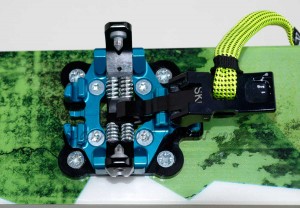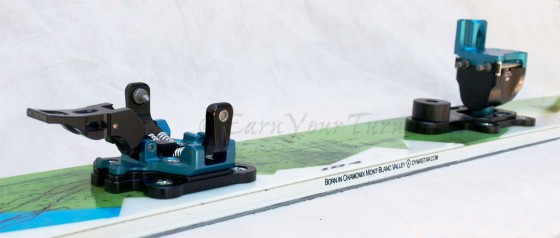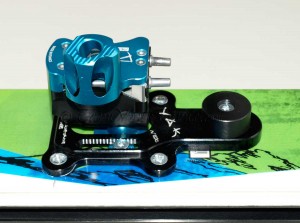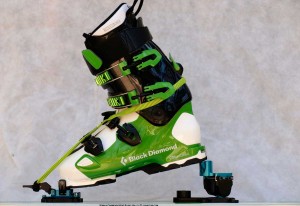First impressions can be deceiving, but not in this case. When you first look at the tech binding from Plum you can’t help but recognize this is more than a two-pin tech binding, it’s a work of craftsmanship.
Nowhere is this more evident than when taking in the look of the Yak, Plum’s widebody tech binding with an anodized blue skin that draws your eyes with its metal beauty. When you dig a bit deeper, you begin to appreciate the simple beauty of these bindings.
Plum’s take on Tech
Beyond visual sparkle is there anything different about a Plum compared to a Dynafit? Not so much, but there are details that could make a difference to the experienced AT skier. Most of them are subtle but the devil is always in the details so here’s some tech nerd minutia to consider.
da Heel
The most obvious difference is the machined metal heel post. Not only does this function as the highest climbing post, it also works as a coupling to let you rotate the heel with your ski pole, whichever way you prefer. That method of shifting gears was abandoned when Dynafit retired their Vertical series of bindings. For those of you who have mastered the magic Dynafiddle mojo move to switch from a locked to a free heel without exiting the binding, a metal volcano is de riguer, especially if you don’t want to be dealing with repairs. Even if you haven’t mastered the trick, but you like using your pole to switch climbing posts and don’t want to be limited to clockwise only rotation you’ll appreciate Plum’s improvement to the concept.
Goin’ Down
In downhill mode it is undeniably a tech binding. As long as you aren’t dealing with high speed vibrations that come from maching down hardpack between gates you shouldn’t need to lock out the release. However, as a tech binding it does have limits to elasticity and if the consequences of pre-release are more likely than those from non-release, man up and lock it out. Of course, you didn’t hear me recommend that but if you’re squeamish about locking out you should consider the piece of mind an extra 4 pounds of plastic placebo provides (via Guardian, Tracker, Duke, Baron, or Adrenaline) instead. LOL!

More mass than your average tech toe, but there still isn’t a lot of material there to put your trust in. Remember, you must believe it to see it.
Durability
How are they for durability? I can’t say that I skied these bindings even dozens of days this past season. Maybe one dozen with the heel locked, plus another dozen as the 2-pin toe of a TTS binding. The latter I consider to be the true test of durability and resistance to premature release since the act of telemarking creates unnatural forces that routinely destroy skis or bindings with legacy telemark gear. The good news is they simply worked, no problems encountered.
Er, not quite. The toes on the Yak did come loose from the baseplate they were mounted to. I added Loctite® and re-tightened them. If you want to make sure it doesn’t loosen, add your own Loctite® and/or always carry a tool to tighten them with. [Note: I use plumbers tape on all my binding inserts. It doesn’t lock the threads, only prevents moisture from corroding the threads of the bolt and the insert. It works, but requires that I also check the bolts as a matter of habit, and I do. Loctite® tape is the better solution.]
Mounting
The Plum Guide and Race bindings use the same mounting pattern as legacy Dynafit bindings, so you can use an old Dynafit jig to mount the toe piece. Plum recommends the Guide which uses this configuration for skis up to 105mm at the waist. For wider skis consider the Yak instead, which comes with a wider mounting plate, 50mm at the toe, under the classic Guide toe, and a baseplate for the heel that allows ±15 mm of adjustment fore and aft in 1 mm increments. Plus it has a rubber bumper under the heel so when the road gets rough you aren’t just suspended between two pins in front and two in back, there’s something for your heel to rest on.
Ramp Angle
The Ramp angle on Plum bindings is pretty low, allowing those who prefer a flatter stance to obtain that without any modifications. Those who want more can easily shim the rear to get the results desired.
Clickin’ In
Brakes?
The one thing most folks take issue with, the lack of a ski brake, will be available this Fall 2013. It attaches at the toe like the ATK ski brake, but of course, with a different design. I’ve only seen one in person for a few brief minutes, so I can hardly comment on it’s durability.
Conclusion
Indeed, one is hard pressed to see anything new or revolutionary in the design of Plum bindings and to the inexperienced it simply looks like a shinier, all-metal version of a Dynafit Vertical ST. In terms of actual functionality that’s a pretty accurate assessment, and therein lies the allure. Fewer parts to fail tends to translate into fewer failures. Perhaps the biggest improvement to Plum is the establishment of a distributor located in Boulder to provide customer service stateside.
Plum
| Model | Price (MSRP) | Weight/pr | Mount Width |
| Yak | $810 | 2.2 lb. – 1.1 kg | 50 mm |
| Guide | $619 | 1.5 lb. – 690 g | 30 mm |
| Race 145 | $679 | 10 oz. – 290 g | 30 mm |
© 2013



